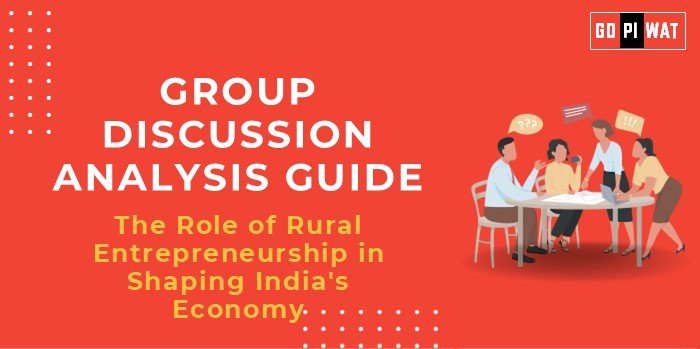📋 Group Discussion (GD) Analysis Guide: The Role of Rural Entrepreneurship in Shaping India’s Economy
🌐 Introduction to the Topic
- 📌 Context Setting: Rural entrepreneurship has emerged as a cornerstone in driving India’s economic transformation by utilizing untapped potential in rural areas. This topic holds immense relevance for B-school discussions, especially as India moves toward inclusive growth and self-reliance.
- 📌 Background: With over 65% of India’s population residing in rural areas, entrepreneurship in these regions has evolved from traditional activities to include sectors like agro-processing, handicrafts, digital services, and tourism. Policies like the PMEGP (Prime Minister’s Employment Generation Programme) and Mudra Yojana have spurred this growth.
📊 Quick Facts and Key Statistics
- 🏠 Rural Population Share: 65% of India’s total population resides in rural areas, highlighting a vast potential market.
- 📈 Contribution to GDP: The rural economy contributes significantly to India’s GDP, with agriculture and allied sectors playing a major role.
- 👩💼 Employment Generation: Rural enterprises provide employment to a substantial portion of the workforce, with many engaged in agriculture and related activities.
- 💳 Financial Inclusion: Under the PMMY, loans amounting to ₹5.20 lakh crore were disbursed in FY24, indicating robust support for rural entrepreneurs.
- 🎓 Skill Development: RSETIs have trained over 4.4 million candidates, with a settlement rate exceeding 70%, showcasing effective skill development initiatives.
🤝 Stakeholders and Their Roles
- 🏛️ Government: Implements policies, provides financial aid, and supports infrastructure development to foster rural entrepreneurship.
- 💼 Private Sector: Invests in rural startups, offers skill development programs, and facilitates market access through digital platforms.
- 🌍 Non-Governmental Organizations (NGOs): Provide training, microfinancing, and assist in market linkage for rural entrepreneurs.
- 👩🌾 Local Communities: Engage in cooperative models and contribute to local supply chains, enhancing economic activities.
🏆 Achievements and ⚠️ Challenges
Achievements
- 💳 Financial Inclusion: The PMMY has significantly enhanced access to credit for rural entrepreneurs, with disbursements surpassing ₹5 lakh crore in FY24.
- 🌐 Market Access: Initiatives like the Open Network for Digital Commerce (ONDC) have enabled rural businesses to reach broader markets, with thousands of Farmer Producer Organizations (FPOs) onboarded.
- 🎓 Skill Development: RSETIs have effectively trained millions, leading to a high settlement rate and empowering rural youth.
Challenges
- 🏗️ Infrastructure Deficits: Inadequate roads, power supply, and internet connectivity hinder the growth of rural enterprises.
- 💵 Financial Barriers: Limited awareness of financial schemes and stringent collateral requirements pose challenges for rural entrepreneurs.
- 📊 Market Saturation: Lack of product diversification leads to intense competition and limited market opportunities.
🌍 Global Comparison
- 🇨🇳 China’s Rural Enterprises: China has successfully leveraged e-commerce and rural industrial clusters to boost rural entrepreneurship, providing valuable lessons for India.
- 🇧🇩 Bangladesh’s Grameen Model: The microfinance model has empowered rural entrepreneurs, particularly women, contributing to economic development.
📖 Case Study
- 🌱 Chhattisgarh’s Tendu Leaves Industry: The state empowered tribal communities by providing better wages and entrepreneurship opportunities in the tendu leaves industry, leading to improved livelihoods.
💡 Structured Arguments for Discussion
- Supporting Stance: “Rural entrepreneurship is a catalyst for inclusive economic growth, reducing urban-rural disparities and fostering self-reliance.”
- Opposing Stance: “Challenges such as inadequate infrastructure and limited market access impede the scalability and sustainability of rural enterprises.”
- Balanced Perspective: “While rural entrepreneurship holds significant potential, addressing infrastructural and financial challenges is crucial for its success.”
🗣️ Effective Discussion Approaches
- 📊 Opening Techniques:
- “With 65% of India’s population residing in rural areas, fostering entrepreneurship in these regions is essential for holistic economic development.”
- “Despite substantial financial disbursements under schemes like PMMY, many rural entrepreneurs still face challenges in accessing markets and infrastructure.”
- 📌 Counter-Argument Handling:
- Acknowledge existing challenges such as infrastructure deficits.
- Highlight successful models and initiatives that have mitigated these challenges.
- Propose pragmatic solutions like enhancing digital connectivity and providing targeted financial support.
📈 Strategic Analysis of Strengths and Weaknesses
- Strengths: Abundant natural resources and raw materials, availability of low-cost labor, and strong government support through various schemes.
- Weaknesses: Inadequate infrastructure facilities, limited access to advanced technology, and dependence on traditional industries with low value addition.
- Opportunities: Expansion of digital platforms facilitating market access, growing demand for organic and indigenous products, and potential for agro-processing and value-added services.
- Threats: Competition from urban enterprises and imported goods, vulnerability to economic fluctuations and natural disasters, and market volatility affecting commodity prices.
🎓 Connecting with B-School Applications
- 🌍 Real-World Applications: Analyzing rural supply chain management in operations courses, studying the impact of microfinance on rural businesses in finance projects, and exploring rural marketing strategies in marketing management.
- 📚 Sample Questions:
- “How can digital platforms empower rural entrepreneurs and enhance market access?”
- “Evaluate the effectiveness of government schemes like PMMY in fostering rural entrepreneurship.”
- “What are the key challenges faced by rural entrepreneurs, and how can they be addressed?”
- 💡 Insights for B-School Students:
- Understanding the dynamics of rural markets and consumer behavior.
- Exploring the role of public-private partnerships in rural development.
- Identifying opportunities for innovation and value addition in rural enterprises.


